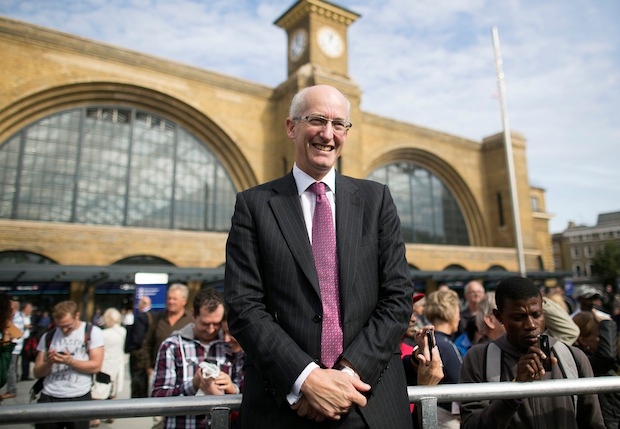I’m sure HS2 chairman Sir David Higgins is right to argue that if we’re serious about building a new north-south rail network, we should get on with it. The greater the number of general elections between conception and completion of any infrastructure scheme, the less likely it is to happen. Lord Mandelson revealed last year that Labour only gave this one the go-ahead in 2009 as a political gimmick; Ed Balls’s comments on it last week signalled that an incoming Labour cabinet might drop the project as casually as it was green-lighted in the first place if it doesn’t suit the short-term politics of 2015.
So the best option for Higgins is to push the boulder uphill a little faster, while finding ways to shave the costs. I think he’s right that greater connectivity and capacity in inter-city rail will help address economic imbalances between north and south, while improving opportunities for growth at both ends; right also that the more northern towns are connected, the more momentum of support there will be. I’m sure I.K. Gricer, Christopher Fildes’s former railway correspondent, has been cheering in his care home at the prospect of Crewe regaining its status as a great transport hub.
But I’m sorry to see — for the second time in recent years — the abandonment of plans for a direct link from the north to the Eurostar network. For a saving of £700 million, HS2 passengers will have to lug their suitcases from Euston to St Pancras for connections to Paris. The consolation is that ugly Euston will be redeveloped and may even have its great Victorian arch reinstalled. I still prefer the idea, sent to me by an Amersham resident whose patio is due to become an HS2 cutting, of leaving Euston as a commuter station and bringing in the track from the north on an eastern route terminating in Kings Cross-St Pancras. But then it’s easy to draw lines across a map, or rub them out again; Higgins will need iron determination, a steady political breeze and very clever accountants if he’s ever to see a spade in the ground for the realisation of HS2.
A culture of whispers
Malaysian Airlines, whose flight MH370 has strangely disappeared, is a national flag-carrier in the broadest sense — a symbol, along with the Petronas Towers in Kuala Lumpur and the Proton car, of its home nation’s aspirations as an Asian Tiger. Hived off in the early 1970s from the former Malaysia-Singapore Airlines, it became, in 1984, one of the first state-owned Asian enterprises to be privatised — and the young banker from London who sweated for ten months to write its prospectus for flotation was none other than your humble columnist.
The airline had every appearance of a modern international business, including a Harvard-educated chief executive. But my assignment was made challenging by a culture of fear and whispering which seemed to pervade the whole country under the rule of its then prime minister, the notably anti-British Dr Mahathir Mohamad. Speaking plain truth was not encouraged — especially for a British expat — and I recall an uncomfortable afternoon in an airless boardroom when almost every interesting fact I had inserted in the draft prospectus was struck out again by my own local colleagues.
It’s possible that I even tried to include an account of the crash of flight MH684 from Singapore to Kuala Lumpur in December 1983 — an incident which involved no fatalities but caused national embarrassment when it was revealed that the pilot had taken over the controls in a heavy rainstorm on the final approach, ignoring instrument warnings, and slammed the plane down in a swamp a mile short of the runway, to the surprise of nearby villagers. The story of MH370 looks far more sinister. But whatever its secrets, don’t expect the Malaysian authorities to offer them readily to the world’s media.
Curious manifesto
How curious that Oxfam should have published a report ahead of the Budget entitled ‘A Tale of Two Britains’, revealing that the five richest households in the country, led by the Duke of Westminster’s, own more than the 12.6 million people who make up the poorest 20 per cent of the population. Curious not because that isn’t an interesting fact — the fifth name on the list is Mike Ashley, the Sports Direct retailer and Newcastle United owner — but because I’ve always thought Oxfam was dedicated to famine relief in the third world, and I’m sure that’s what donors and customers of its high-street shops think too. But here it is publishing what might pass for an old-fashioned Labour manifesto, about ‘raising revenue through progressive taxation and balancing the books on the shoulders of those who can afford it’. Perhaps this venerable charity should change its name, so that we’re not confused by its new purpose.
Acquaintance with sin
The Quakers of Hull must be spinning in their graves. Among their 19th-century brethren were the Reckitts, whose laundry starch business merged with the mustard-making interests of the Colmans from Norfolk. Along the way they acquired disinfectant brands such as Dettol and Harpic. Having famously prospered from ‘the mustard left on the side of the plate’, Reckitt & Colman sold its food arm to Unilever and merged with Benckiser of the Netherlands to form the world’s leading maker of hygienic cleaning products. Then modernity crept in: 2009 brought a new corporate identity. ‘Contemporary and bold, it reflects Reckitt Benckiser’s spirit… “The Power behind the Powerbrands”.’ Whatever that may mean, the next addition was SSL, maker of Durex condoms. And this month the group’s acquaintance with sin was completed by the acquisition of the $100 million K-Y ‘intimate lubricants’ brand from Johnson & Johnson, ‘to create a unique portfolio in the sexual wellbeing category’. Dear oh dear; imagine pitching that to old Isaac Reckitt in the 1850s as a diversification from starch.







Comments